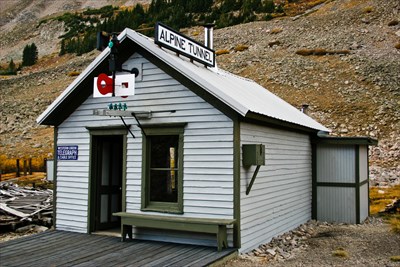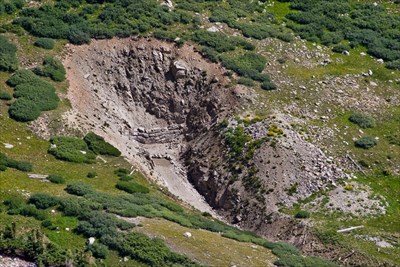
Alpine Tunnel Historic District - Pitkin, CO
N 38° 38.437 W 106° 24.463
13S E 377486 N 4277836
The Alpine Tunnel Historic District incorporates 13 miles of the original Denver, South Park and Pacific Railroad. The tunnel itself was the first constructed through the Continental Divide and began service in 1882.
Waymark Code: WMFE6D
Location: Colorado, United States
Date Posted: 10/05/2012
Views: 6
The Alpine Tunnel Historic District is located primarily in Gunnison County, Colorado, with a small portion in Chaffee County, Colorado. The district boundary follows the original railbed and right-of-way of the Denver, South Park and Pacific Railroad (DSP&P). It runs 13.3 contiguous miles to a width of 30 meters on either side of the railbed centerline. The district also includes features such as the Alpine Tunnel, the Alpine Tunnel Station complex, the Sherrod townsite, portions of the townsites of Hancock and Quartz, three construction camps, one water tank, a telegraph line, a wagon road and the Palisades. The Denver, South Park and Pacific Railroad and its successors (the Denver, Leadville and Gunnison Railway and the Colorado and Southern Railway) were in use for only 30 years. The railroad and its associated features slowly deteriorated following their abandonment in 1910.
Excerpt from the Alpine Tunnel NRHP registration form [visit link]
 The Alpine Tunnel, constructed from 1880 to 1881, became the first railroad tunnel through the continental divide. At the time it was the highest in the world at an elevation of 11,612 feet. The tunnel was constructed by the Denver, South Park and Pacific (DSP&P) Railroad to link Denver to the rich mining districts of central Colorado and eventually made it as far as Gunnison. The railroad never realized its dream of reaching the Pacific coast and was abandoned in 1910.
The Alpine Tunnel, constructed from 1880 to 1881, became the first railroad tunnel through the continental divide. At the time it was the highest in the world at an elevation of 11,612 feet. The tunnel was constructed by the Denver, South Park and Pacific (DSP&P) Railroad to link Denver to the rich mining districts of central Colorado and eventually made it as far as Gunnison. The railroad never realized its dream of reaching the Pacific coast and was abandoned in 1910.
Although the tunnel has caved in and much of the area has succumbed to the harsh alpine winters, a few of the historical structures have been restored. You can get a feel for what it would have been like to ride the train by following the 10 mile road along the actual railroad grade. The road is not maintained during the winter so June through September are the best months to visit.
 The Alpine Tunnel Historic District begins at the townsite of Quartz near Pitkin. It follows the railroad grade including 100 feet of right-of-way on either side. About three miles up the road, the remnants of the Midway water tank can be seen. The tank is one of three between Quartz and the tunnel that serviced locomotives struggling up the mountain. The next water tank is the Tunnel Gulch tank which has been restored and is one of the best examples along the South Park rail system.
The Alpine Tunnel Historic District begins at the townsite of Quartz near Pitkin. It follows the railroad grade including 100 feet of right-of-way on either side. About three miles up the road, the remnants of the Midway water tank can be seen. The tank is one of three between Quartz and the tunnel that serviced locomotives struggling up the mountain. The next water tank is the Tunnel Gulch tank which has been restored and is one of the best examples along the South Park rail system.
Further up along the road lies the historic townsite sf Woodstock. In 1884 an avalanche buried the town, killing 13 of the 16 residents living there. The stone pedestals of a water tank are all that remain today. Continuing on, an impressive 228 degree turn in the rail line, known as the Sherrod Loop, makes a u-turn to continue climbing back up the valley. Another impressive engineering feat along the route are the palisades, a series of rock walls built to support the tracks as they traverse very narrow cliffs. The largest is 33 feet high and 425 feet long. The large stones were entirely had cut and fitted without the use of mortar. Remarkably, over 130 years later, the walls are still in excellent condition.
 The highlight of the district is the Alpine Tunnel and station complex. Construction on the tunnel began in January 1880 and nearly two years later became the first tunnel through the North American Continental Divide. The first trains ran through the tunnel in June of 1882 and lasted just under 30 years until the line was abandoned in 1910. With an apex that reaches 11,612 feet, it is still the highest railroad tunnel in North America and the longest narrow gauge tunnel at 1,772 feet. Unfortunately the harsh alpine weather has not been kind to the tunnel. The east portal has completely collapsed and landslides have covered the west portal entombing the rails and redwood support beams that still lie inside. Several stones lining the top of the west portal can still be viewed and a trail over Altman Pass provides access to the east portal.
The highlight of the district is the Alpine Tunnel and station complex. Construction on the tunnel began in January 1880 and nearly two years later became the first tunnel through the North American Continental Divide. The first trains ran through the tunnel in June of 1882 and lasted just under 30 years until the line was abandoned in 1910. With an apex that reaches 11,612 feet, it is still the highest railroad tunnel in North America and the longest narrow gauge tunnel at 1,772 feet. Unfortunately the harsh alpine weather has not been kind to the tunnel. The east portal has completely collapsed and landslides have covered the west portal entombing the rails and redwood support beams that still lie inside. Several stones lining the top of the west portal can still be viewed and a trail over Altman Pass provides access to the east portal.
About 1/3 mile downgrade from the tunnel is the Alpine Tunnel Station Complex which provided support for the trains and helper locomotives that traveled along the route. Several of the buildings have been restored by volunteers and interpretive signs provide information on the rich history. Among those buildings that have been preserved is the telegraph office, built in 1890. It served as both a telegraph and dispatch office for the railroad. A wooden coaling platform has also been restored. Across the tracks lies the ruins of a stone engine house constructed in 1881 and destroyed by a fire 1906. The engine house contained a water tank and turntable, the remnants of which can still be seen. After the fire, a new turntable and water tank were constructed closer to the tunnel. The wooden turntable platform has been restored but the water tank was moved to Boreas Pass in 1910 where it is known as the Baker Tank. Also located at the Station Complex are the ruins of a stone section house built in 1881 and abandoned in 1896 and a two story wooden boarding house which contained a kitchen, dining room and bedrooms.
The district terminates at the ghost town of Hancock about 3 miles from the east portal of the tunnel.
Sources: NRHP Registration Form, Alpine Tunnel Historic District & Alpine Tunnel History by Nathan Holmes